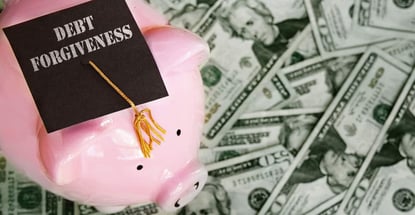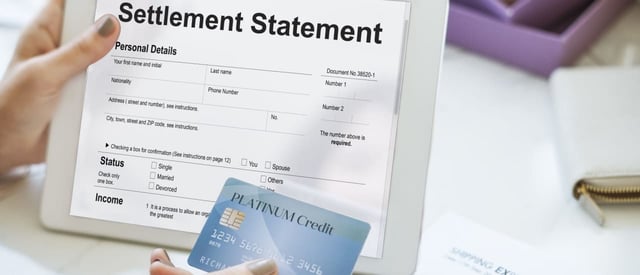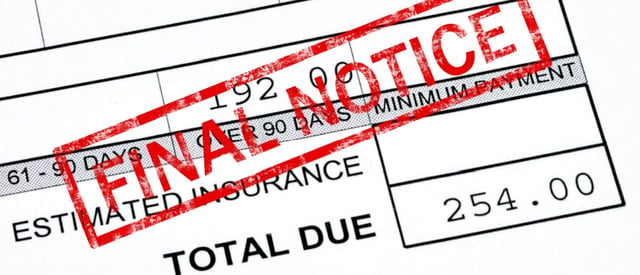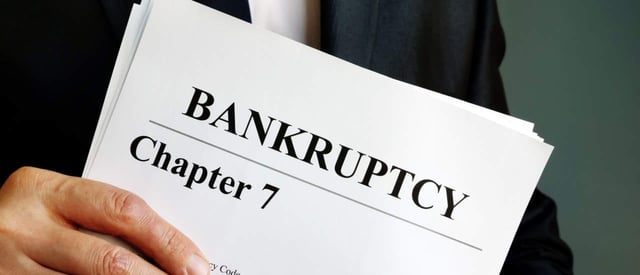
Opinions expressed here are ours alone, and are not provided, endorsed, or approved by any issuer. Our articles follow strict editorial guidelines and are updated regularly.
There is nothing quite like being forgiven. Maybe you hurt a friend, and they told you everything is fine now. Or you made a mistake at work, and your boss gave you a reprieve.
Credit card companies can also give you a break sometimes. And if not, there are other debt forgiveness options to explore. Here is how you may be able to walk away from some or even all of your credit card bills.
1. Negotiate With Your Credit Card Issuer
If you can’t afford to pay the entire credit card bill and your financial problems aren’t temporary, your first course of action is to call the issuer. Ask if you can pay less than the amount due. In some situations, the issuing bank may work with you.
For example, imagine you have a $5,000 debt that you acquired when you were working, but you are now on government assistance. Suppose you can barely scrape together enough money for your necessary monthly expenses, but you have a couple thousand dollars saved up that you can offer the issuer right away. See if they will agree to let you off the hook for the remainder.

Although there are no guarantees that the credit card issuer will accept your offer, it doesn’t hurt to explain your circumstances and request special assistance.
If you can provide proof that your financial problems are both severe and permanent, this may be the best arrangement for the credit card issuer too. It can avoid having to place plenty of collection calls, send letters, and then have the account go into collections where the bank would lose money anyway.
2. Turn to a Debt Settlement Company
Another method to deal with overwhelming credit card balances is to work with a debt settlement company. Many of these firms promise to reduce consumer accounts by 50% or even more. In fact, they also handle other debts, such as unsecured personal loans and delinquent medical bills.
Debt settlement companies will usually have you open a special savings account where you will deposit a fixed amount of money every month instead of paying your bills. When the credit card issuers charge the accounts off and send them to collections (or sometimes before that happens), the debt settlement company will negotiate with each of the creditors on your behalf.

Many debt settlement companies impose a minimum debt amount, such as $10,000, to work with you. That amount may be on one account or several. The debt settlement company charges a fee for this service that is usually a percentage of the amount you didn’t have to pay.
For example, imagine you owe a total of $15,000. The debt settlement company was able to cut that liability in half, wiping away $7,500 from your obligation.
But, if it charges a 20% fee, that would add $1,500 to the amount you have to pay — making it $9,000 instead of the original $15,000. Still a pretty decent discount in the end.
Of course, you would have to weigh the benefit of money saved against the drawback of damaged credit that the missed payments and collection action would cause. And be sure to work with an accredited company with a good reputation, such as Golden Financial Services.
3. Work With a Collection Agency
Your credit card debt may be close to going into collections because you have missed more than six consecutive payments, in which case you already have damaged credit. The credit card company will typically sell the account to a third-party collection agency for considerably less than what you owe.
At that stage, the collection agency will own the debt and attempt to collect the entire amount due. Anything you pay over their purchase price is profit (minus overhead, such as paying the person who calls you asking for the money).

For example, let’s say your credit card balance was $1,000. The agency purchased the account for $40 (not that you will ever know that figure, but the standard is four cents on the dollar). If the debt just recently went into collection, the company may not shave too much off the amount you owe, but if you haven’t paid in several years, you have a better chance of getting a significant amount of it forgiven.
This is especially true if the statute of limitations has passed, which is the time period within which the creditor can sue you for the outstanding balance. Each state has different laws, so check them out before you attempt to negotiate.
As scary as it can be to communicate with a collector, it can work to your benefit. In many cases, you can come to an agreement where you pay less than the collector requests, which can save you the fee a debt settlement company would charge.
4. File for Chapter 7 Bankruptcy
Chapter 7 bankruptcy is the most common form of personal bankruptcy in the US and lets you walk away from allowable credit card balances. There are no specific limits to how much you can have wiped away in Chapter 7. So if you owe $100,000 in credit card bills, that’s the amount you can have forgiven.
But there are a few circumstances in which you will be stuck paying the full amount. For example, you can’t include credit card debt that you incurred for luxury purchases and cash advances that you took out shortly before you filed.
You will also be stuck with the debt if you used the credit card for non-dischargeable debts, such as for fraudulent transactions or to pay off most student loans.

Discharging debt in a Chapter 7 bankruptcy definitely has some downsides. First, you have to qualify. If you earn more than the median household income for your state, you will have to pass a means test, which gauges your ability to pay for the debt you currently hold. If you don’t pass, your bankruptcy petition will likely be denied.
Also, be aware that Chapter 7 bankruptcy has serious ramifications. It will stay glued to your credit report for a total of 10 years, dramatically lowering your credit score (unless it’s already at the bottom). This can negatively affect your ability to get future loans, credit cards, and sometimes even rent a home.
5. File For Chapter 13 Bankruptcy
Another type of bankruptcy available is Chapter 13, which arranges a repayment plan over three or five years. During that time, you would make one monthly payment to the courts, and the bankruptcy trustee will route it to your creditors.
You can include a variety of secured liabilities in a Chapter 13 bankruptcy — even a delinquent mortgage, which can stop a foreclosure — but you will have to pay them in full. The unsecured balances that remain after the bankruptcy is complete, though, are usually forgiven.
So, if you included $50,000 worth of credit card debt in a Chapter 13 bankruptcy and there was still a $30,000 balance by the time your repayment arrangement is complete, in most cases, you would not be responsible for paying the remaining balance.

Chapter 13 bankruptcies are much more complicated than Chapter 7 bankruptcies. You have to demonstrate that you can afford to make the monthly payments, and you may have to change your lifestyle because elaborate expenses, such as vacations or buying nice cars, may be disallowed. Chapter 13 will stay on your credit report for seven years.
Debt Forgiveness Alternatives
There are a few ways you can catch a break on your credit debt that aren’t as drastic as having them forgiven. For example:
- Debt management plan. Nonprofit credit counseling agencies offer debt management plans to consumers struggling with debt. These plans allow you to pay your credit card bills, and most credit card companies have agreed to lower the interest; some even eliminate it while you pay through the agency. You will satisfy your entire debt in full, which can save or even repair your credit, and because you’re not paying as much interest, you’re still getting a break.
- Debt consolidation loan. You can save a lot of money if you have high interest credit card debt and can get a debt consolidation loan with a lower cumulative interest rate. If this sounds appealing, make sure your credit is in good shape because the rate that you will be offered is largely dependent on your credit score.
- Balance transfer to a 0% APR credit card. Another option is to have your credit card balance absorbed by a new credit card that offers a 0% APR on balance transfers for a long time period. Although the total amount of card debt you owe won’t decrease as it could with forgiveness options, you can still save a good amount of money if you pay off the balance before the APR increases to the regular rate.
Finally, Beware the IRS and Debt Forgiveness
Sometimes it’s impossible to pay the entirety of your credit card liabilities. In that case, choose the best debt forgiveness option for you, but know in advance that the canceled sum can be considered income.
According to the IRS, if you borrow money from a commercial lender (such as a bank or credit card issuer) and the lender then cancels some or all of the debt, you may have to include the forgiven amount as income for tax purposes.
![9 Things to Know About Credit Card Debt Forgiveness ([updated_month_year]) 9 Things to Know About Credit Card Debt Forgiveness ([updated_month_year])](https://www.cardrates.com/images/uploads/2021/02/Credit-Card-Debt-Forgiveness.jpg?width=158&height=120&fit=crop)

![[current_year] Credit Card Debt Statistics (Average U.S. Debt) [current_year] Credit Card Debt Statistics (Average U.S. Debt)](https://www.cardrates.com/images/uploads/2018/04/shutterstock_243114739-edit.jpg?width=158&height=120&fit=crop)
![Apply For a Prepaid Card: 5 Best Card Options ([updated_month_year]) Apply For a Prepaid Card: 5 Best Card Options ([updated_month_year])](https://www.cardrates.com/images/uploads/2022/09/Apply-For-a-Prepaid-Card.jpg?width=158&height=120&fit=crop)
![7 Options to Get Cashback on a Credit Card ([updated_month_year]) 7 Options to Get Cashback on a Credit Card ([updated_month_year])](https://www.cardrates.com/images/uploads/2015/11/Cashback-Credit-Card.png?width=158&height=120&fit=crop)
![Credit Card Reconsideration: Phone Numbers, Tips & Options ([updated_month_year]) Credit Card Reconsideration: Phone Numbers, Tips & Options ([updated_month_year])](https://www.cardrates.com/images/uploads/2017/12/recon.jpg?width=158&height=120&fit=crop)
![7 Options When Your Credit Card APR Rises ([updated_month_year]) 7 Options When Your Credit Card APR Rises ([updated_month_year])](https://www.cardrates.com/images/uploads/2018/11/shutterstock_591898394-edit1.jpg?width=158&height=120&fit=crop)
![Citi Credit Card Preapproval Options ([updated_month_year]) Citi Credit Card Preapproval Options ([updated_month_year])](https://www.cardrates.com/images/uploads/2022/03/Citi-Credit-Card-Preapproval.jpg?width=158&height=120&fit=crop)